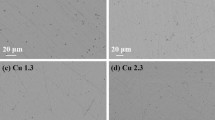Abstract
The homogeneous coarse-grained (CG) Cu–Ni alloys with nickel concentrations of 9, 26, 42, and 77 wt% were produced from as-cast ingots by homogenization at 850 °C followed by quenching. The subsequent high-pressure torsion (5 torsions at 5 GPa) leads to the grain refinement (grain size about 100 nm) and to the decomposition of the supersaturated solid solution in the alloys containing 42 and 77 wt% Ni. The lattice spacing of the fine Cu-rich regions in the Cu–77 wt% Ni alloy was measured by the X-ray diffraction (XRD). They contain 28 ± 5 wt% Ni. The amount of the fine Ni-rich ferromagnetic regions in the paramagnetic Cu–42 wt% Ni alloy was estimated by comparing its magnetization with that of fully ferromagnetic Cu–77 wt% Ni alloy. According to the lever rule, these Ni-rich ferromagnetic regions contain about 88 wt% Ni. It means that the high-pressure torsion of the supersaturated Cu–Ni solid solutions produces phases which correspond to the equilibrium solubility limit at 200 ± 40 °C (Cu–77 wt% Ni alloy) and 270 ± 20 °C (Cu–42 wt% Ni alloy). To explain this phenomenon, the concept of the effective temperature proposed by Martin (Phys Rev B 30:1424, 1984) for the irradiation-driven decomposition of supersaturated solid solutions was employed. It follows from this concept that the deformation-driven decomposition of supersaturated Cu–Ni solid solutions proceeds at the mean effective temperature T eff = 235 ± 30 °C. The elevated effective temperature for the high-pressure torsion-driven decomposition of a supersaturated solid solution has been observed for the first time. Previously, only the T eff equal to the room temperature was observed in the Al–Zn alloys.






Similar content being viewed by others
References
Kunimine T, Aragaki T, Fujii T et al (2011) J Mater Sci 46:4302. doi:10.1007/s10853-010-5243-4
Rebhi A, Makhlouf T, Champion Y et al (2011) J Mater Sci 46:2185. doi:10.1007/s10853-010-5056-5
Wang CT, Gao N, Wood RJK et al (2011) J Mater Sci 46:123. doi:10.1007/s10853-010-4862-0
Kawasaki M, Mendes AD, Sordi VL et al (2011) J Mater Sci 46:155. doi:10.1007/s10853-010-4889-2
Zrnik J, Pippan R, Scheriau S et al (2010) J Mater Sci 45:4822. doi:10.1007/s10853-010-4482-8
Martin G (1984) Phys Rev B 30:1424
Delogu F (2009) Mater Chem Phys 115:641
Xi SQ, Zuo KS, Li XG et al (2008) Acta Mater 56:6050
Delogu F (2008) Scripta Mater 58:126
Jiang WH, Atzmon M (2006) Scripta Mater 54:333
Ye J, Liu JW, Enrique RA et al (2003) Scripta Mater 49:969
Sheng HW, Lu K, Ma E (1999) J Appl Phys 85:6400
Xu J, Collins GS, Peng LSJ et al (1999) Acta Mater 47:1241
Ma E, Atzmon M (1995) Mater Chem Phys 39:249
Adda Y, Beyeler M, Brebec G (1975) Thin Solid Films 25:107
Roussel JM, Bellon P (2002) Phys Rev B 65:144107
Wei LC, Averback RS (1997) J Appl Phys 81:613
Soisson F, Bellon P, Martin G (1992) Phys Rev B 46:11332
Valiev RZ, Estrin Y, Horita Z et al (2006) JOM 4:33
Valiev RZ, Langdon TG (2006) Prog Mater Sci 51:881
Valiev R, Islamgaliev R, Alexandrov I (2000) Prog Mater Sci 45:103
Straumal BB, Kogtenkova OA, Protasova SG et al (2011) J Mater Sci 46:4243. doi:10.1007/s10853-011-5257-6
Straumal BB, Baretzky B, Mazilkin AA et al (2004) Acta Mater 52:4469
Mazilkin AA, Straumal BB, Rabkin E et al (2006) Acta Mater 54:3933
Straumal BB, Mazilkin AA, Protasova SG et al (2009) Mater Sci Eng A 503:185
Straumal BB, Dobatkin SV, Rodin AO et al (2011) Adv Eng Mater 13:463
Prokoshkin SD, Khmelevskaya IY, Dobatkin SV et al (2005) Acta Mater 53:2703
Li W, Li X, Guo G et al (2009) Appl Phys Lett 94:231904
Straumal BB, Mazilkin AA, Protasova SG et al (2011) Kovove Mater Metall Mater 49:17
Mazilkin AA, Abrosimova GE, Protasova SG et al (2011) J Mater Sci 46:4336. doi:10.1007/s10853-011-5304-3
Massalski TB (ed) (1990) Binary alloy phase diagrams. ASM International, Materials Park, OH
Coles BR (1955–1956) J Inst Metals 84:346
Lihl F, Ebel H, Reichl A et al (1968) Z Metallkunde 59:735
Mazilkin AA, Kogtenkova OA, Straumal BB et al (2005) Def Diff Forum 237:739
Straumal BB, Mazilkin AA, Protasova SG et al (2008) Acta Mater 56:6246
Straumal BB, Baretzky B, Mazilkin AA et al (2009) J Eur Ceram Soc 29:1963
Jesser WA, Shneck RZ, Gile WW (2004) Phys Rev B 69:144121
Mehrer H (ed) (1990) Diffusion in solid metals and alloys, Landolt-Börnstein New Series, Gr III, vol 26. Springer-Verlag, Berlin
Schaeffer H-E (1987) Phys Stat Sol (a) 102:47
Straumal BB, Klinger LM, Shvindlerman LS (1984) Acta Metall 32:1355
Molodov DA, Straumal BB, Shvindlerman LS (1984) Scripta Metall 18:207
Divinski SV, Reglitz G, Rösner H et al (2011) Acta Mater 59:1974
Amouyal Y, Divinski SV, Estrin Y et al (2007) Acta Mater 55:5968
Bellon P, Averback RS (1995) Phys Rev Lett 74:1819
Acknowledgements
The investigations were partly supported by Russian Foundation for Basic Research (contracts 09-03-92481, 09-08-90406 and 11-08-90439) and Israel Ministry of Science (contract 3-5790). Authors cordially thank Prof. A.M. Gusak for stimulating discussions.
Author information
Authors and Affiliations
Corresponding author
Rights and permissions
About this article
Cite this article
Straumal, B.B., Protasova, S.G., Mazilkin, A.A. et al. Deformation-driven formation of equilibrium phases in the Cu–Ni alloys. J Mater Sci 47, 360–367 (2012). https://doi.org/10.1007/s10853-011-5805-0
Received:
Accepted:
Published:
Issue Date:
DOI: https://doi.org/10.1007/s10853-011-5805-0




